Eurovans
| Eurovans | |
|---|---|
_%E2%80%93_Frontansicht%2C_9._April_2011%2C_D%C3%BCsseldorf.jpg) Peugeot 807 (facelift), one of the four Eurovan versions | |
| Overview | |
| Manufacturer | Sevel Nord |
| Production | March 1994 – June 2014 |
| Assembly | Lieu-Saint-Amand, France (Sevel) |
| Body and chassis | |
| Class | Large MPV (M) |
| Body style | 5-door MPV |
| Layout | Front-engine, front-wheel-drive |
| Related | Sevel Nord vans |
| Chronology | |
| Successor |
Fiat Freemont Lancia Voyager Citroën Space Tourer Peugeot Traveller |
The Eurovans are a family of large MPVs from the Citroën, Peugeot, Fiat and Lancia marques that were produced at the jointly-owned Sevel Nord factory in France. The term Eurovan was not used by the brands themselves in sales literature, but rather by the motoring press to refer to the vans collectively. It was launched in March 1994, and production ceased in November 2010 for the Fiat and Lancia models, and in June 2014 for the Citroën and Peugeot siblings.[1]
The Eurovans differ little technically and visually, being a prime example of badge engineering. They share mechanicals and body structure with the Sevel Nord light commercial vans, the Citroën Jumpy (Dispatch), Fiat Scudo and Peugeot Expert.[2]
The first generation Eurovans were marketed as the Citroën Evasion, Fiat Ulysse, Lancia Zeta and Peugeot 806. The second generation models were all renamed, except the Fiat Ulysse, with the nameplates now Citroën C8, Lancia Phedra and Peugeot 807.
First generation (1994–2002)
| First generation | |
|---|---|
 1998 Citroën Evasion | |
| Overview | |
| Also called |
Citroën Evasion Citroën Synergie Fiat Ulysse Lancia Zeta Peugeot 806 |
| Production | March 1994 – February 2002 |
| Body and chassis | |
| Platform | Sevel Nord vans |
The first generation Eurovans were introduced in 1994. They are smaller than American vans, like the Chrysler Voyager, which is also available in Europe. In contrast to the Toyota Previa and like American minivans they had sliding rear side doors, a trait they share with their commercial siblings. In spite of the fact that the Voyager also came in the "Grand" versions with elongated body and wheelbase (and the Espace followed suit in 1997), the Eurovans only came in one size.
The Eurovans were almost identical, the differences consisting in different grilles, lower tailgates/taillights, wheel covers/alloy wheels and exterior and interior badging, as well as different trim levels. In October 1998, the Eurovans were mildly facelifted.
Inside, the gear lever was mounted on the dashboard rather than on the floor, and the handbrake is on the door side of the driver's seat, which allowed for the removal of middle console and opened up a passage between the front seats. The seating configurations included two fixed seats in front and three individual removable seats in the middle row, along with optional two individual removable seats or a three-seater bench in the third row.
Engines
The first-generation Eurovans utilized PSA's XU/XUD engines, regardless of brand. They were later replaced by the PSA EW/DW engine. All were mated to 5-speed manual transmissions, apart from the 2.0 16v EW petroleum engine, which had an option of a 4-speed automatic.
| Name | Fuel | Volume | Output | Torque | Engine code | Notes |
|---|---|---|---|---|---|---|
| 1.8 8v | Petrol | 1,761 cc (1.761 L; 107.5 cu in) | 99 PS (73 kW; 98 hp) @5750 rpm | 147 N·m (108 lb·ft) @2600 rpm | XU7 | Not available for Lancia Zeta, phased out in 2000 |
| 2.0 8v | Petrol | 1,998 cc (1.998 L; 121.9 cu in) | 121 PS (89 kW; 119 hp) @5750 rpm | 170 N·m (130 lb·ft) @2650 rpm | XU10 2C | Not available for Lancia Zeta, phased out in 2000 |
| 2.0 16v | Petrol | 1,998 cc (1.998 L; 121.9 cu in) | 132 PS (97 kW; 130 hp) @5500 rpm | 180 N·m (130 lb·ft) @4200 rpm | XU10 J4 | Phased out in 2000 |
| 2.0 16v | Petrol | 1,997 cc (1.997 L; 121.9 cu in) | 136 PS (100 kW; 134 hp) @6000 rpm | 190 N·m (140 lb·ft) @4100 rpm | EW10 J4 | Optional automatic transmission; replaced all previous petroleum engines in July 2000 |
| 2.0 8v Turbo | Petrol | 1,998 cc (1.998 L; 121.9 cu in) | 147 PS (108 kW; 145 hp) @5300 rpm | 235 N·m (173 lb·ft) @2500 rpm | XU10 J2TE | Phased out in 2000 |
| 1.9 8v TD | Diesel | 1,905 cc (1.905 L; 116.3 cu in) | 90 PS (66 kW; 89 hp) @4000 rpm | 196 N·m (145 lb·ft) @2250 rpm | XUD9 | Phased out in 2000, not available for Lancia Zeta |
| 2.1 12v TD | Diesel | 2,088 cc (2.088 L; 127.4 cu in) | 109 PS (80 kW; 108 hp) @4300 rpm | 250 N·m (180 lb·ft) @2000 rpm | XUD11 | Phased out in 2000 |
| 2.0 8v HDi/JTD | Diesel | 1,997 cc (1.997 L; 121.9 cu in) | 109 PS (80 kW; 108 hp) @4000 rpm | 250 N·m (180 lb·ft) @1750 rpm | DW10ATED | PSA's new HDI engine, billed JTD by Fiat in spite of that; introduced in January 2000 to replace both previous diesels |
| 2.0 16v HDi/JTD | Diesel | 1,997 cc (1.997 L; 121.9 cu in) | 109 PS (80 kW; 108 hp) @4000 rpm | 270 N·m (200 lb·ft) @1750 rpm | DW10ATED4 | 16-valve version of previous engine, introduced in 2001 |
Model differences
Citroën Evasion
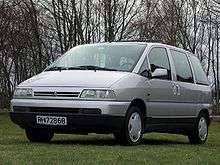
.jpg)
The Evasion was badged Synergie in the RHD markets of both the United Kingdom and Ireland. However, the car maintained the Evasion name in New Zealand. In 1998, the Citroën Evasion got a slight facelift, including a larger logo and a restyling of the front grille and rear bumper.
Peugeot 806

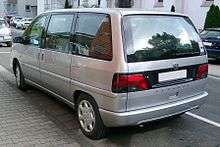
The 806 was named according to Peugeot's "x0x" system, where the first digit indicates model series (vehicle size/class) and the last indicates the generation, with a central zero. The largest Peugeot series then available was the executive saloon 605, so Peugeot chose 8, potentially leaving room for an in between model. The Eurovans were launched when Peugeot was replacing the "x05" with "x06" models, so it was appropriately labeled "806".
Fiat Ulysse

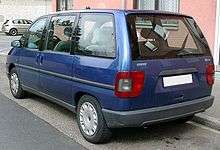
The Fiat was named after Ulysses, the Roman name for Odysseus, the hero of Homer's Odyssey. The Ulysse range received a facelift in 1999.
Lancia Zeta


Following the traditional naming theme, Lancia named its variant with the previously unused Greek letter Zeta. With its big chrome grille, the Lancia served as the "premium" Eurovan, not available with base engines and exceptionally well equipped, with prices up to 20% higher than corresponding versions of other Eurovans.
Second generation (2002–2014)
| Second generation | |
|---|---|
|
Fiat Ulysse (second generation) | |
| Overview | |
| Production |
June 2002 – June 2014 (Citroën and Peugeot) June 2002 – November 2010 (Fiat and Lancia) |
| Body and chassis | |
| Platform | Sevel Nord vans |
| Dimensions | |
| Wheelbase | 2,823 mm (111.1 in) |
| Length |
4,727 mm (186.1 in) (Peugeot 807) 4,750 mm (187.0 in) (Lancia Phedra) |
| Width |
1,854 mm (73.0 in) (Peugeot 807) 1,863 mm (73.3 in) (Lancia Phedra) |
| Height | 1,752 mm (69.0 in) (Peugeot 807) |
| Curb weight |
|
In 2002 the second generation of the Eurovans was launched. The 807 itself was launched in June, followed by the C8 in July.[3] The floorpan, wheelbase, and postponement were not transformed, but all exterior dimensions-including front and rear tracks- were increased. The increase in length of almost 30 cm greatly enhanced interior volume. The new Eurovans were afforded a much more bubbly, contemporary look, along with a modern-looking dashboard with centrally mounted gauges.
The differences between the various versions were more marked, surrounding full front fascias and rear sections (including head- and tail-lights), as well as different interior colour themes. The middle and third row seats now had fore/aft sliders to increase flexibility and also adjustable backs. As with the first generation, a three-seater bench seat was available in the third row, slotting into the standard third row seat runners, with back-lowering and tilt forward arrangements to increase boot space.
The Citroën C8 and Peugeot 807 also got a light facelift in 2008.
The Fiat and the Lancia were slightly wider than PSA vans, and the Phedra was also longer than other Eurovans.[4]
To highlight the launch of the V6 engine, Peugeot presented a design study called Peugeot 807 Grand Tourisme at the 2003 Geneva Motor Show. Despite the fancier 4-passenger interior and some mechanical and visual tuning, the car was essentially a top-of-the-line 807 in a purple colour.
Engines
The engine range comprised again of different versions of the PSA EW/DW engine, paired with either 5-speed manual or 4-speed automatic transmissions. (A six-speed manual option was added in the UK in late 2004). Additionally, top-of-the-line versions came with the PSA ES V6.
All diesels were PSA's HDIs, but allocated JTD by Fiat also.
| Name | Fuel | Volume | Output | Torque | Engine code | Notes |
|---|---|---|---|---|---|---|
| 2.0 16v | Petrol | 1,997 cc (1.997 L; 121.9 cu in) | 136 PS (100 kW; 134 hp) @6000 rpm | 190 N·m (140 lb·ft) @4100 rpm | EW10 J4 | Later replaced by the new 140 PS version of the same engine |
| 2.0 16v | Petrol | 1,997 cc (1.997 L; 121.9 cu in) | 140 PS (103 kW; 138 hp) @6000 rpm | 200 N·m (150 lb·ft) @4000 rpm | EW10 A | Replaced the 136 PS version; not available for Fiat or Lancia |
| 2.2 16v | Petrol | 2,230 cc (2.23 L; 136 cu in) | 158 PS (116 kW; 156 hp) @5650 rpm | 217 N·m (160 lb·ft) @3900 rpm | EW12 J4 | Not available for Fiat or Lancia |
| 3.0 24v | Petrol | 2,946 cc (2.946 L; 179.8 cu in) | 204 PS (150 kW; 201 hp) @6000 rpm | 285 N·m (210 lb·ft) @3750 rpm | ES9 | Added in 2003, only available with automatic transmission |
| 2.0 16v HDi/JTD | Diesel | 1,997 cc (1.997 L; 121.9 cu in) | 109 PS (80 kW; 108 hp) @4000 rpm | 270 N·m (200 lb·ft) @1750 rpm | DW10 | |
| 2.0 16v HDi/JTD | Diesel | 1,997 cc (1.997 L; 121.9 cu in) | 120 PS (88 kW; 118 hp) @4000 rpm | 300 N·m (220 lb·ft) @2000 rpm | DW10 | |
| 2.0 16v HDi/JTD | Diesel | 1,997 cc (1.997 L; 121.9 cu in) | 136 PS (100 kW; 134 hp) @4000 rpm | 320 N·m (240 lb·ft) @2000 rpm | DW10 BTED4 | |
| 2.2 16v HDi/JTD | Diesel | 2,179 cc (2.179 L; 133.0 cu in) | 128 PS (94 kW; 126 hp) @4000 rpm | 314 N·m (232 lb·ft) @2000 rpm | DW12 TED4 | The engine code used in Eurovans is 4HW. Only available with manual transmission, in 2005 changed to 6-speed |
| 2.2 16v HDi/JTD | Diesel | 2,179 cc (2.179 L; 133.0 cu in) | 170 PS (125 kW; 168 hp) @4000 rpm | 370 N·m (270 lb·ft) @1500 rpm | DW12 | From 2008 new 2.2 bi-TURBO |
Model differences
Citroën C8
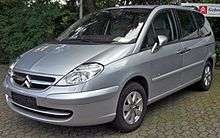

Citroën chose to put the minivan in line with its new naming theme, where models were called Cx (x being a number roughly corresponding to the relative size of a given model), hence the Citroën C8.
Peugeot 807
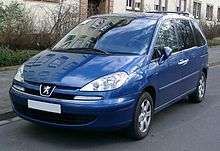

The 807 replaced the 806.
Fiat Ulysse

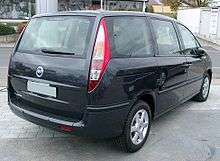
Fiat retained the Ulysse name for its second generation. The direct successor is the Fiat Freemont.[5]
Lancia Phedra

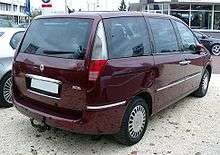
As the new Lancias didn't use Greek letters in the 2000s (until the Lancia Delta was reintroduced in 2008), the new minivan was called Lancia Phedra, in honor of the Greek mythological figure Phaedra. The successor is the Lancia Voyager.
Sales and production figures
| Year | Worldwide Production | Worldwide Sales | Notes | ||
|---|---|---|---|---|---|
| 807 | C8 | 807 | C8 | ||
| 2004 | TBA | TBA | 31,200[6] | TBA | |
| 2005 | TBA | TBA | 27,500[6] | TBA | |
| 2006 | TBA | TBA | 24,200[6] | TBA | |
| 2007 | TBA | TBA | 21,100[6] | TBA | |
| 2008 | TBA | TBA | 13,500[6] | TBA | |
| 2009 | 6,200[7] | TBA | 7,100[7] | 5,800[7] | |
| 2010 | 5,700[7] | TBA | 5,700[7] | 5,500[7] | |
| 2011 | 6,376[3] | 5,731[3] | 6,345[3] | 5,540[3] | Total 807 production reaches 185,190 units. Total C8 production reaches 143,761 units.[3] |
| 2012 | 4,200[8] | 3,700[8] | 4,500[8] | 4,100[8] | Total 807 production reaches 189,400 units. Total C8 production reaches 147,500 units.[8] |
References
- ↑ "Fin de parcours pour les Peugeot 807 et Citroen C8". Auto Plus (in French). 30 June 2014. Retrieved 12 August 2014.
- ↑ "Fiat Scudo Van Range : Do you do Scudo?". Yahoo!. Retrieved 26 November 2011.
- 1 2 3 4 5 6 "PSA Annual Report 2012". PSA. Archived from the original on 22 July 2016.
- ↑ Nowy Auto Katalog. Motor Presse Polska. 2006. pp. 191–271. ISSN 1233-0973. – technical data based on 2005/06 models
- ↑ "New model: Fiat Freemont". Italiaspeed.com. 16 June 2011. Retrieved 9 April 2012.
- 1 2 3 4 5 "PSA". Psa-peugeot-citroen.com. 19 May 2011. Retrieved 23 May 2011.
- 1 2 3 4 5 6 "Engine specs from PSA Peugeot Citroën" (PDF). Creator and designer. PSA Peugeot Citroën. Retrieved 9 April 2013.
- 1 2 3 4 5 "PSA Annual Report 2013". PSA. Archived from the original on 22 July 2016.
| « previous — Citroën car timeline, 1980s–present | |||||||||||||||||||||||||||||||||||||
|---|---|---|---|---|---|---|---|---|---|---|---|---|---|---|---|---|---|---|---|---|---|---|---|---|---|---|---|---|---|---|---|---|---|---|---|---|---|
| Type | 1980s | 1990s | 2000s | 2010s | |||||||||||||||||||||||||||||||||
| 0 | 1 | 2 | 3 | 4 | 5 | 6 | 7 | 8 | 9 | 0 | 1 | 2 | 3 | 4 | 5 | 6 | 7 | 8 | 9 | 0 | 1 | 2 | 3 | 4 | 5 | 6 | 7 | 8 | 9 | 0 | 1 | 2 | 3 | 4 | 5 | 6 | |
| Economy car | 2CV | ||||||||||||||||||||||||||||||||||||
| Off-roader | Méhari | ||||||||||||||||||||||||||||||||||||
| City car | C1 I | C1 II | |||||||||||||||||||||||||||||||||||
| Supermini | LN / LNA | AX | |||||||||||||||||||||||||||||||||||
| Dyane | Axel | Saxo | C2 | DS3 | |||||||||||||||||||||||||||||||||
| Visa | C3 I | C3 II | |||||||||||||||||||||||||||||||||||
| Small family car | C4 Cactus | ||||||||||||||||||||||||||||||||||||
| GSA | ZX | Xsara | C4 I | C4 II | |||||||||||||||||||||||||||||||||
| DS4 | |||||||||||||||||||||||||||||||||||||
| Large family car | BX | Xantia | C5 I | C5 II | |||||||||||||||||||||||||||||||||
| DS5 | |||||||||||||||||||||||||||||||||||||
| Executive car | CX | XM | C6 | ||||||||||||||||||||||||||||||||||
| Convertible | Visa cabriolet | C3 Pluriel | |||||||||||||||||||||||||||||||||||
| Mini MPV | Nemo Multispace | ||||||||||||||||||||||||||||||||||||
| Compact MPV | Xsara Picasso | C3 Picasso | |||||||||||||||||||||||||||||||||||
| C4 Picasso I | C4 Picasso II | ||||||||||||||||||||||||||||||||||||
| Large MPV | Evasion | C8 | |||||||||||||||||||||||||||||||||||
| Crossover SUV | C-Crosser | C4 Aircross | |||||||||||||||||||||||||||||||||||
| LAV | Acadiane | C15 | Nemo | ||||||||||||||||||||||||||||||||||
| Berlingo | Berlingo II | ||||||||||||||||||||||||||||||||||||
| Van | H Van | C25 | Jumpy I | Jumpy II | Space Tourer | ||||||||||||||||||||||||||||||||
| C35 | Jumper I | Jumper II | |||||||||||||||||||||||||||||||||||
| « previous — Peugeot, a marque of Groupe PSA since 1976, car and LCV timeline, 1980s–present | |||||||||||||||||||||||||||||||||||||
|---|---|---|---|---|---|---|---|---|---|---|---|---|---|---|---|---|---|---|---|---|---|---|---|---|---|---|---|---|---|---|---|---|---|---|---|---|---|
| Type | 1980s | 1990s | 2000s | 2010s | |||||||||||||||||||||||||||||||||
| 0 | 1 | 2 | 3 | 4 | 5 | 6 | 7 | 8 | 9 | 0 | 1 | 2 | 3 | 4 | 5 | 6 | 7 | 8 | 9 | 0 | 1 | 2 | 3 | 4 | 5 | 6 | 7 | 8 | 9 | 0 | 1 | 2 | 3 | 4 | 5 | 6 | |
| City car | iOn | ||||||||||||||||||||||||||||||||||||
| 107 | 108 | ||||||||||||||||||||||||||||||||||||
| Supermini | 104 | 106 | 207 | 208 | |||||||||||||||||||||||||||||||||
| 205 | 206 | 206+ | |||||||||||||||||||||||||||||||||||
| Small family car | 305 | 301 | |||||||||||||||||||||||||||||||||||
| 309 | 306 | 308 | 308 | ||||||||||||||||||||||||||||||||||
| 307 | 408 | ||||||||||||||||||||||||||||||||||||
| Large family car | 504 | 405 | 406 | 407 | 508 | ||||||||||||||||||||||||||||||||
| 505 | |||||||||||||||||||||||||||||||||||||
| Executive car | 604 | 605 | 607 | ||||||||||||||||||||||||||||||||||
| Coupé | 406 Coupé | 407 Coupé | |||||||||||||||||||||||||||||||||||
| RCZ | |||||||||||||||||||||||||||||||||||||
| Convertible | 205 Cabriolet | 206 CC | 207 CC | ||||||||||||||||||||||||||||||||||
| 306 Cabriolet | 307 CC | 308 CC | |||||||||||||||||||||||||||||||||||
| Mini MPV | 1007 | ||||||||||||||||||||||||||||||||||||
| Compact MPV | 5008 | ||||||||||||||||||||||||||||||||||||
| Large MPV | 806 | 807 | |||||||||||||||||||||||||||||||||||
| Crossover | 2008 | ||||||||||||||||||||||||||||||||||||
| 3008 | |||||||||||||||||||||||||||||||||||||
| SUV | 4007 | 4008 | |||||||||||||||||||||||||||||||||||
| LAV | Bipper | ||||||||||||||||||||||||||||||||||||
| Partner | Partner | ||||||||||||||||||||||||||||||||||||
| LCV | J5 | Expert | Expert | Traveller | |||||||||||||||||||||||||||||||||
| J7 | J9 | Boxer | Boxer | ||||||||||||||||||||||||||||||||||
| « previous — Fiat car timeline (Europe), 1980s–present | ||||||||||||||||||||||||||||||||||||||||||||||||
|---|---|---|---|---|---|---|---|---|---|---|---|---|---|---|---|---|---|---|---|---|---|---|---|---|---|---|---|---|---|---|---|---|---|---|---|---|---|---|---|---|---|---|---|---|---|---|---|---|
| Type | 1980s | 1990s | 2000s | 2010s | ||||||||||||||||||||||||||||||||||||||||||||
| 0 | 1 | 2 | 3 | 4 | 5 | 6 | 7 | 8 | 9 | 0 | 1 | 2 | 3 | 4 | 5 | 6 | 7 | 8 | 9 | 0 | 1 | 2 | 3 | 4 | 5 | 6 | 7 | 8 | 9 | 0 | 1 | 2 | 3 | 4 | 5 | 6 | ||||||||||||
| City car | 126 | Cinquecento | Seicento / 600 | |||||||||||||||||||||||||||||||||||||||||||||
| 500 | ||||||||||||||||||||||||||||||||||||||||||||||||
| Panda I | Panda II | Panda III | ||||||||||||||||||||||||||||||||||||||||||||||
| Supermini | Hatch | 127 | Uno | Punto I | Punto II | |||||||||||||||||||||||||||||||||||||||||||
| Palio | Grande Punto | Punto Evo | Punto | |||||||||||||||||||||||||||||||||||||||||||||
| Saloon | Duna | Siena | Albea | |||||||||||||||||||||||||||||||||||||||||||||
| Small family car | Hatch | Ritmo | Tipo | Bravo I / Brava | Stilo | Bravo II | Tipo | |||||||||||||||||||||||||||||||||||||||||
| Saloon | 131 | Regata | Tempra | Marea | Linea | Tipo | ||||||||||||||||||||||||||||||||||||||||||
| Large family car | 132 | Argenta | Croma I | Croma II | ||||||||||||||||||||||||||||||||||||||||||||
| Cabriolet | Ritmo Cabrio | Punto Cabrio | 500C | |||||||||||||||||||||||||||||||||||||||||||||
| Coupé | 3P | Coupé | ||||||||||||||||||||||||||||||||||||||||||||||
| Spider | Spider 2000 / Europa | Barchetta | Barchetta | 124 Spider | ||||||||||||||||||||||||||||||||||||||||||||
| Sports car | X1/9 | |||||||||||||||||||||||||||||||||||||||||||||||
| LCV/LAV | Fiorino I | Fiorino II | Fiorino III / Qubo | |||||||||||||||||||||||||||||||||||||||||||||
| Doblò I | Doblò II | |||||||||||||||||||||||||||||||||||||||||||||||
| Mini SUV | Sedici | 500X | ||||||||||||||||||||||||||||||||||||||||||||||
| Mini MPV | Idea | 500L | ||||||||||||||||||||||||||||||||||||||||||||||
| Compact MPV | Multipla | |||||||||||||||||||||||||||||||||||||||||||||||
| Large MPV | Ulysse I | Ulysse II | Freemont | |||||||||||||||||||||||||||||||||||||||||||||
| Van | Daily | Scudo I | Scudo II | |||||||||||||||||||||||||||||||||||||||||||||
| Talento | ||||||||||||||||||||||||||||||||||||||||||||||||
| Ducato I | Ducato II | Ducato III | ||||||||||||||||||||||||||||||||||||||||||||||
| Mini pickup | Strada | |||||||||||||||||||||||||||||||||||||||||||||||
| Pickup | Fullback | |||||||||||||||||||||||||||||||||||||||||||||||
| Off-road | Campagnola (1107) | |||||||||||||||||||||||||||||||||||||||||||||||
| Legend |
| |||||||||||||||||||||||||||||||||||||||||||||||
| « previous — Lancia car timeline, 1980s–present | |||||||||||||||||||||||||||||||||||||
|---|---|---|---|---|---|---|---|---|---|---|---|---|---|---|---|---|---|---|---|---|---|---|---|---|---|---|---|---|---|---|---|---|---|---|---|---|---|
| Type | 1980s | 1990s | 2000s | 2010s | |||||||||||||||||||||||||||||||||
| 0 | 1 | 2 | 3 | 4 | 5 | 6 | 7 | 8 | 9 | 0 | 1 | 2 | 3 | 4 | 5 | 6 | 7 | 8 | 9 | 0 | 1 | 2 | 3 | 4 | 5 | 6 | 7 | 8 | 9 | 0 | 1 | 2 | 3 | 4 | 5 | 6 | |
| Supermini | A112 | Y10 | Y | Ypsilon I | Ypsilon II | ||||||||||||||||||||||||||||||||
| Small family car | Delta I | Delta II | Delta III | ||||||||||||||||||||||||||||||||||
| Compact executive car | Beta | Prisma | Dedra | Lybra | |||||||||||||||||||||||||||||||||
| Beta Trevi | |||||||||||||||||||||||||||||||||||||
| Executive car | Gamma | Thema I | Kappa | Thesis | Thema II | ||||||||||||||||||||||||||||||||
| Coupé | Beta Coupé | ||||||||||||||||||||||||||||||||||||
| Gamma Coupé | Kappa Coupé | ||||||||||||||||||||||||||||||||||||
| Cabriolet | Flavia II | ||||||||||||||||||||||||||||||||||||
| Mini MPV | Musa | ||||||||||||||||||||||||||||||||||||
| Large MPV | Zeta | Phedra | Voyager | ||||||||||||||||||||||||||||||||||
| Sports car | Montecarlo | Delta HF 4WD/integrale | |||||||||||||||||||||||||||||||||||
| Rally 037 | Delta S4 | ||||||||||||||||||||||||||||||||||||
| Rally car | Rally 037 | Delta S4 | Delta HF Group A | ||||||||||||||||||||||||||||||||||
| Racing car | Montecarlo Turbo | LC1 | LC2 | ||||||||||||||||||||||||||||||||||